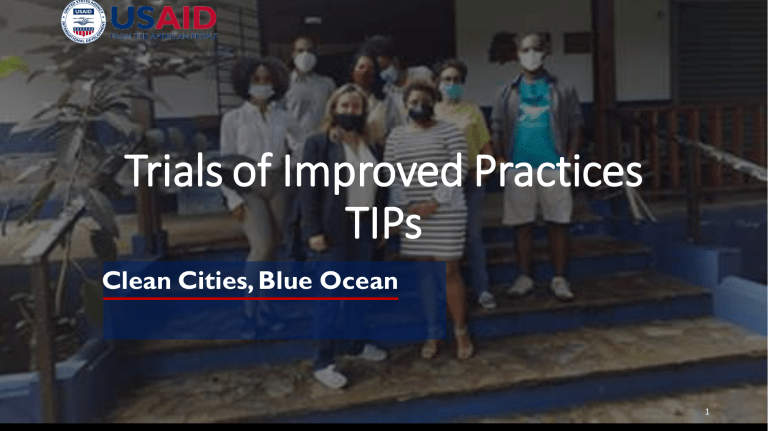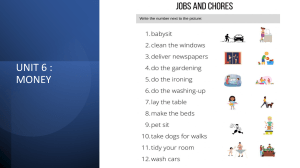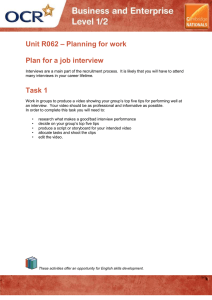
Trials of Improved Practices TIPs Clean Cities, Blue Ocean 1 Agenda Day 1 • Fun way to start the day • Learning objectives • TIPs: what it is and its history • Negotiation: good practices and role play (break?) • Sample, TIPS and Behavior • First TIPs Interview questions and Current Behavior Recording form • • Practice using the form • Role play using first interview and Current Behavior Recording Form ( break?) TIPs menu (break?) ----------------------------------------------------------------------------------------- (Probably will be all that we can get to on Tuesday) • What to do after the 1 s t visit interview is completed and form filled out? • • • Explaining dangers of waste to environment; Explaining what specific things that household is doing that is risky for the environment Asking what the participant would like to do differently to lessen the risks/recommending behaviors to try from the TIPs menu • Behavioral Commitment Recording form (for interviewer) • Behavioral Commitment Reminder form (for TIPs participant) • Demonstration role play of first interview 2 Agenda Day 2 • Review Day One and TIPs menu • Review Negotiation for Visit 1 • Role plays using first interview schedule and Current Behavior Recording Form • Role play whole first TIP visit including practice using Current Behavior Recording Form, Behavioral Commitment form, and Behavioral Commitment Reminder (break?) • Second TIPs visit and role plays of second TIPs visit (break?) • Adapt and learn how to use data analysis form • Role plays of second visit; after the role play, record the data using the data analysis form (break?) • Using the summary data form for data analysis • Making program recommendations using the data analysis form and summary data analysis form 3 TIPs was developed in Indonesia in 1979 by Marcia Griffiths 4 TIPS is • An iterative research technique (usually 3 visits) • 1st: Learn about the behaviors the household (or could be a business) is doing and something about the family or person • You have already found out most of this during the household visit (so that is like the first visit) • 2nd: Negotiate behavior that the TIP participant will try during the TIP and obtain a behavioral commitment • 3rd: Follow up to see how the participant/s did https://www.manoffgroup.com/resources/ Nutrition Designing by Dialogue (download) 5 Usual TIPs Visits • Often TIPS are conducted with a different sample from the sample for the qualitative research. For this reason: • There are usually 3 TIPs visits • #1 To learn demographic information and other information [you have already learned this from the qualitative household study], as well as observation of the household’s behavior [No observation during the pandemic] • #2 The negotiation visit (based on the observation and visit #1)—the object is to facilitate the TIP participant to try new or modified behavior that is less risky for the environment • #3 The final visit to find out how the household did: whether the participant could or couldn’t do the behavior or changed the behavior and why 6 Our TIP Visits • Only 2 visits • #1 Find out more detail on the behaviors, decide which of the household’s behaviors are risky for the environment and are feasible to change and negotiate new or modified behaviors to try out during the coming week (the TIP) We are combining what are usually the first and second visits • Why? • #2 Follow up visit to find out whether TIPs participant and her/his household did the behaviors, did not do the behaviors or changed the behaviors and why 7 TIPs: for the birds? 8 Negotiation • Gradual • Additive • Neither party winds up where they started • In TIPs, the negotiating partner is the judge, not the accused. • No TIPs participant should ever be forced to commit to something s/he truly does not want to do • How is negotiation different from coercion? 9 Mental Models and Negotiation • What is a mental model? • The ways individuals understand social and physical systems, for example: how individuals understand negotiation • Various models for negotiation • Haggling (competitive—trying to win) • Game playing (trying to win through out-maneuvering) • Partnership (willingness to take short-term losses to sustain long-term relationship) • Problem solving (collaborative, accommodative) • Cannot ignore social structure in negotiation, which skews the negotiation in favor of the person with the highest status (e.g., class, color, ethnicity, etc.) 10 First TIP Visit: Before You Start the TIP: Be Prepared before you leave 1. Find the household interview form for each household that you will be responsible for interviewing 2. Take a blank form for recording the current behaviors for each household from the household interview; each household will get its own form 3. Using the answers on that household’s interview form from the household interviews that you did, fill out the form for recording current behaviors for each household—you will not be able to fill in everything from the earlier interview; you must ask about the missing information in the TIP interview 4. Do this for every household you will interview and don’t mix up households! Use the same alphanumeric for TIPs as you did for the household interviews 11 Take with you to first interview • Copy of TIPs participant’s household study interview form • Blank TIPs first interview form • Current Behavior Recording form (filled out from household interview) • Participant behavioral commitment form (to give to participant) • IEC material to give to TIPs participant about how to segregate waste • Behavior Recording Form 12 Current Behavior Recording Form (used in the first visit) Answer # in family: Segregate waste for pigs? If yes, who in household does it Compost? Answer Answer Segregate any other waste? If yes, who does it If yes, what do with it? Who does it Use container? What container? Where keep compost? What use it for? Who does it? 13 Page 2 Burn yard waste? What burn? Plastics included in waste burned? Who burns? Where Burned? Residual Waste burned? Who Burns? What else burned with it? Where burned? Used Toilet Paper Burned Who Burns? What else burned with it? Used Pampers Burned? Who Burns? What else burned with it? 14 Page 3 Used sanitary napkins/ tampons/other person products burned? Who Burns? What else burned with it? Dispose of trash in environment/ who does? What trash put in environment Where put the Trash disposed of in the environment? Regular waste collection (formal sector)? How frequently Describe household trash container Where is it kept? 15 Page 4 Recycle? What recycle? Where recyclable container kept? Room for bags in home? Place to hang bags? Who handles trash in household? Other important behaviors noted Describe: (including who puts trash into receptacle; who takes out to truck) 16 Page 5 Analysis of behaviors from First Visit Environmentally risky behaviors practiced by household: • 1. ______________________________________________________________________________________ • ______________________________________________________________________________________ 1. ______________________________________________________________________________________ • ______________________________________________________________________________________ 1. ______________________________________________________________________________________ • ______________________________________________________________________________________ 1. ______________________________________________________________________________________ • ______________________________________________________________________________________ 1. ______________________________________________________________________________________ • _______________________________________________________________________________________ 17 Page 6 1. • _______________________________________________________________________________________ ________________________________________________________________________________________ • • • Environmentally friendly behaviors practiced by household: • 1._____________________________________________________________________________________________ • _______________________________________________________________________________________________ • 2. _____________________________________________________________________________________________ • _______________________________________________________________________________________________ • 3. ____________________________________________________________________________________________________________________________________ _____________________________________________________________ • _________________________________________________________________________________________________________________________________ ________________________________________________________________ • 4. ____________________________________________________________________________________________________________________________________ ___________________________________________________________ • _________________________________________________________________________________________________________________________________ _________________________________________________________________ • 5. ____________________________________________________________________________________________________________________________________ _____________________________________________________________ 18 Behavior Recording Form Alphanumeric interview date 1 st Behaviors Agreed to Try 2nd Phone # or NA Comments Interview Date/time 19 Sample Participant Commitment Date: I commit to try doing the following behaviors for one week, until [name of researcher] returns to talk with me again. 1. 2. 3. 4. (etc.) Participant’s name 20 Take with you to Second TIPs Interview • First TIPs Interview form 21 • [Be 100% certain before you go to the community that you have the form with the record of the agreement for each household that you will visit. Also take a copy of the Current Behavior Form for each household that you plan to visit, so you can refer back to the response, if necessary.] • Make sure that you are talking with the same person with whom you have talked on previous visits. For TIPs visits, it’s fine if others inside (but not outside) the household are listening and participating because SWM and 3R involve whole household behaviors. • Re-establish rapport. • Ask the TIP participant to remind you what s/he (the household) agreed to do during the past week. (check it against the agreement list to make sure they agree). It may be that the participant forgot or couldn’t or didn’t want to do what s/he agreed to. That’s also important information. • • Tell the participant that often in TIPs we learn more from people who could not do what they agreed to do than we do from people who were able to do it. Remind the participant that what is being tested is whether the behaviors they agreed to do make sense to recommend to people like them.You are not testing her/him, you are testing the recommended behaviors. 22 • For each behavior that the participant agreed to do, ask whether s/he or the household was able to do it. o If the person was able to do it, ask: ▪ ▪ ▪ ▪ ▪ ▪ Did you change what we agreed to in any way? • If yes, ask: how did you change it? What did you do instead? • Ask the reasons that the person changed it • What got in the way of you doing the behavior we agreed to? • How did the change work out? What made this easier to do? (If no change) Was there anything that made the behavior difficult to do? What about it made it difficult? (If no change) How did you handle that? (If no change) How did you feel about doing it? Did you discuss this trial and what you agreed to do with anyone? What did you say? 23 Individual or City Summary Analysis Sheet Behavior Did Did Not Do Changed How Changed Intend to Continue Recommend 24 Final TIPs visit Recording Form Participant ID# Behavior Did Did Not Do Changed? How and why Supports/Constraints Comments/Attitude 25 Summary Analysis Sheet Behavior Did Did Not Do Changed How Changed Intend to Continue Recommend 26 END OF DAY 2 27

